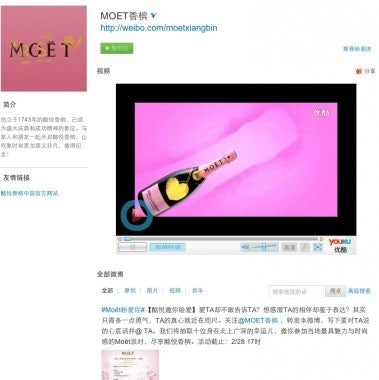Wine-Growing Regions Turn To Microblogging To Reach Key Chinese Demographic#

By this point, it's clear that Sina Weibo is an indispensable tool for luxury and auto brands to reach millions of tech-savvy Chinese, but in order to maintain their dominance in the contentious and booming China wine market, French winemakers and wine-growing regions too are turning to the microblogging platform in a big way. Though American and Australian winemakers are increasing their efforts both on the ground in China and online in order to better position themselves to compete with their French rivals, the competitive advantage of French wines in terms of reputation in the young Chinese market have kept them far ahead in import volume and sales. As the Grape Wall of China blog noted last month, French wine currently enjoys more than half of China's imported wine market share, with imports from France rising nearly 74 percent last year to 117.9 million liters, far ahead of Australia, South Africa and Portugal. But with interest in New World wines growing, particularly among younger middle-class Chinese -- the country's most tech-savvy -- Weibo is becoming a critical part of more French winemakers' marketing strategies.
This week, the Bordeaux winery Château Brane-Cantenac joined regional organizations like the Conseil Interprofessionel du Vins de Bordeaux (CIVB) and Les Huit de Loire, importers like JX Bordeaux, and high-profile brands like Moët & Chandon in launching a Weibo page aimed at educating potential drinkers and brand-building for the China market. According to Brane-Cantenac's official website, "We launched our Weibo account this week to continue to communicate regularly with Chinese customers and 'fans,' and hope to increase our follower base as quickly as possible. The potential is enormous because the Chinese are avid users of this new medium to stay in touch with their families, friends and colleagues."
Though most French wineries use Weibo more for educational purposes rather than for specific promotions, it is interestingly Moët & Chandon that has been recently been among the most active in using the microblogging platform to tout its individual products. Though champagne continues to lag far behind red wine in sales in China, Moët has sought to leverage the popularity of Weibo to raise its visibility, launching recent efforts like its "Mr. and Mrs. Moët" contest alongside on-the-ground events in Beijing and Shanghai, and changing the look of its Weibo page to promote its rosé champagne around Valentine's Day. Although champagne and spirits brands continue to be among the lowest-ranked among prestige brands using social media in China, with the category coming in dead last in terms of Chinese-language and e-commerce functionality on their websites according to the L2 Prestige 100 China IQ survey, recent efforts from the likes of Moët and Johnnie Walker indicate that they're now taking digital marketing seriously in China.
As for Bordeaux, recent efforts on Weibo seem set on positioning the wine-growing region as the best in France -- a task that has become far more difficult in the past year as wealthy Chinese have diversified into drinking and collecting top Burgundy, Sauternes and champagne, and urban "post-80s" white collar workers have given more inexpensive New World wines a shot. For its part, using the ”Bonjour Bordeaux" (#Bonjour 波尔多#) hashtag, the CIBV tries to introduce new drinkers to the history and heritage of Bordeaux wines, sharing philosophical tidbits and making cultural references in an attempt to appeal to younger Weibo users. Still, that might not be sufficient to compete with the relative hipness, giveaways and contests on Moët's page.
